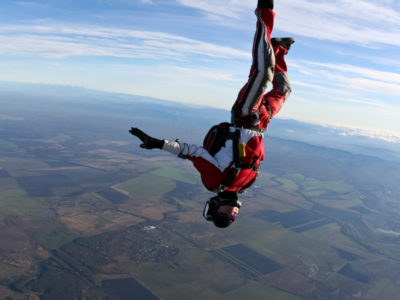Skydiving accessories aren’t just about taking your skydiving outfit to the next level. No, rather, like many other niche sports, the deeper into skydiving you go, the more varied the accouterments you acquire. Along the way, you’ll pick up skydiving accessories that help make life as a skydiver much easier and much safer!
While there is a list of essential skydiving equipment anyone needs to jump, keep reading for some additional skydiving accessories that come with the territory of being an experienced skydiver.
Top Skydiving Accessories Explained
Hair Buff
No long-haired lad or lady experienced jumper will jump without this skydiving accessory. As you can imagine, the mega wind of a 120 mph freefall can tousle your tresses and make for some seriously gnarly knots. The simple use of this accessory can save your scalp from the rigorous post-skydiving hair brushing you’d most definitely need without it!
Skydiving Gloves
Skydiving gloves aren’t just used to protect a jumper’s hands in the chill of winter. Skydiving gloves are a popular item amongst competitive skydivers. Members of skydiving teams will use white gloves so that their hands can be clearly seen as they build formations. This increased visibility helps to ensure that the judges award them every point they deserve.
Additionally, in the event, that you are required to grip the door of the aircraft, the bar, or the little ledge the farthest rear floater and cameramen cling to for an exit, gloves add an extra layer of protection from potential scrapes.

Custom Skydiving Container
You will never forget the feeling of ordering your first custom skydiving container. At Skydive Monroe, we provide the skydiving rig for our student skydivers, and we also have rental skydiving rigs for newly licensed solo jumpers. But there’s something about a piece of skydiving equipment completely customized to your exact measurements and designed by you with your specific aesthetic preferences in mind that really makes you feel like you’ve “leveled up”.
From specific color swatches to asymmetrical designs, the custom skydiving container is how experienced skydivers show off their creative side.
Parachute Packing Tool
Skydiving containers are specifically designed to hold a certain range of parachute sizes. Usually, skydivers will purchase their first skydiving container with the ability to downsize to smaller parachutes as they progress. This means that, often, the first canopy a jumper has is a snug fit within the skydiving rig, and as such, it requires some extra muscle to close the skydiving container.
Well, when you’re aiming to put in a full day of jumping, if there’s any way you can save some energy and make your life easier, you take it! When you begin to pack that fresh new canopy in your nifty custom skydiving container, a parachute packing tool will be your best friend.
The parachute packing tool is designed to help close the main container without wearing down your hands with pull-up cords. The design of the parachute packing tool helps provide better pulling leverage and aids in an efficient packing process. For the experienced skydiver, the parachute packing tool is an indispensable skydiving accessory.
Full-Face Skydiving Helmet
Student skydivers typically wear an open-faced helmet throughout the course of their student progression. This type of helmet covers the head but not the face. Often, one of the first purchases a newly licensed skydiver makes is a full-face skydiving helmet. A full-face skydiving helmet, as the name implies, covers both the head and face of a jumper.
One type of helmet is not necessarily better than the other. It’s all a matter of preference.
Those who skydive solo or in disciplines where clear verbal communication is needed like Canopy Relative Work, tend to prefer the feeling of the wind on their face and utilize an open-face helmet setup. Those who jump with groups on formation skydives need a bit more protection from accidental elbows to the nose and other bumps among friends, so, they will usually elect to purchase a full-face skydiving helmet.
Hook Knife
The hook knife is a skydiving tool that many experienced skydivers carry but hope they never have to use. In the extremely unlikely event of entanglement with another jumper while beneath a parachute, a hook knife can be used to cut the parachute lines and free the entangled skydiver. The mentality around carrying a hook knife is that it is much better to have it and not need it than to need it and not have it.
Removable Deployment System
 A technical parachute item that a skydiver might acquire once they are a bit more advanced is a removable deployment system or an RDS. The deployment system includes a pilot chute, deployment bag, and slider. When an RDS is installed, the slider becomes removable after deployment through a cable and ring system. In order to utilize the full RDS, the deployment bag is attached to the slider as opposed to the top of the parachute. This enables the removal of the full deployment system once the slider is removed.
A technical parachute item that a skydiver might acquire once they are a bit more advanced is a removable deployment system or an RDS. The deployment system includes a pilot chute, deployment bag, and slider. When an RDS is installed, the slider becomes removable after deployment through a cable and ring system. In order to utilize the full RDS, the deployment bag is attached to the slider as opposed to the top of the parachute. This enables the removal of the full deployment system once the slider is removed.
An RDS is generally used to improve visibility and reduce drag for skydivers who are looking for that extra push of canopy speed.
Whether you are just learning about essential items or what to wear for your first skydive, or you’re ready to take skydiving to the next level, contact Skydive Monroe to learn even more today!
Copyright © 2025, Skydive Monroe, All Rights Reserved.
DropZone Web Design & Marketing by Beyond Marketing, LLC



